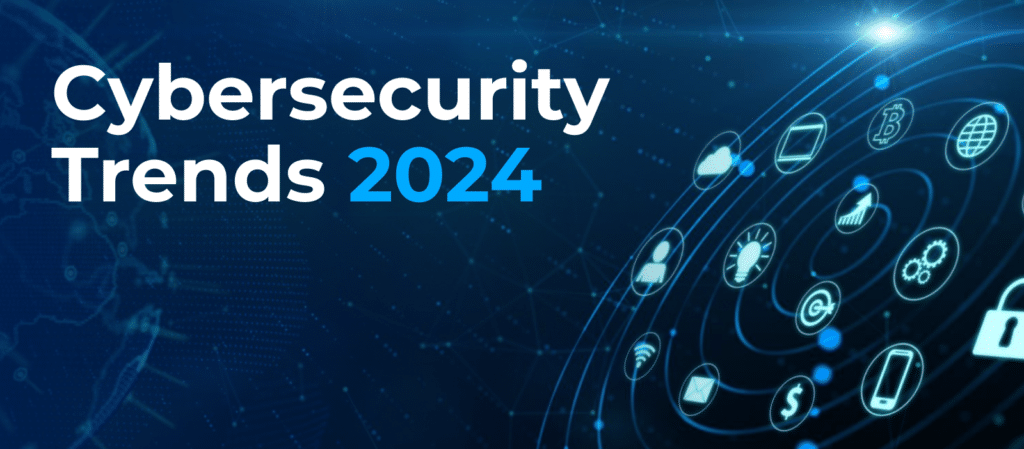Cybersecurity trends to watch in 2024

As the digital landscape continuously evolves, staying abreast of cybersecurity trends is crucial for safeguarding information in 2024. This article delves into pivotal security concerns and practices that will define the cyber protection industry in the forthcoming year.
From the advent of AI-driven security measures to the growing importance of end-user education, we uncover the top trends that organizations and individuals should prepare for. Addressing these trends is essential for defending against the sophisticating cyber threats that are on the rise.
Cybersecurity: The Frontline of Digital Defense in 2024
As we march into 2024, the digital realm sees an exponential increase in data creation, compelling the need for robust cybersecurity strategies. The amplification of cyber threats demands adaptive and proactive security measures to protect sensitive data and maintain privacy.
With the integration of Internet of Things (IoT) devices in our daily lives, securing these interconnected technologies becomes paramount. Innovations in this space offer promising advancements but also present new vulnerabilities that malicious actors can exploit.
Moreover, the complexity of cloud services and their widespread adoption necessitate a stronger focus on cloud security. Organizations are now prioritizing the protection of their cloud-based assets, recognizing that a breach could have catastrophic consequences.
Enhancing security measures through artificial intelligence and machine learning is becoming a cornerstone of modern cybersecurity strategies. These technologies offer the capability to predict, detect, and respond to threats with unprecedented speed and accuracy.
Emphasizing Resilience Through Cyber Hygiene
Good digital hygiene practices are more critical than ever in bolstering defenses against cyber adversaries. Adopting robust password policies and regular software updates are simple yet effective steps in enhancing security.
Another critical aspect is the Best practices in IT security, which outlines the foundational steps organizations can take to fortify their infrastructure against digital threats. This encompasses not only technological safeguards but also the policies and procedures that support them.
Phishing attacks continue to be a prevalent method used by cybercriminals to gain unauthorized access. Educating employees on identifying and responding to these threats is vital for maintaining organizational security integrity.
Artificial Intelligence: A Double-Edged Sword
While AI presents opportunities for improving cybersecurity, it also poses significant risks. AI-driven attacks are becoming more sophisticated, capable of automating cyberattacks and evading detection with greater ease.
On the flip side, AI and machine learning technologies are instrumental in developing security systems that can learn from past incidents, thereby improving threat detection and response times.
Organizations must remain vigilant and continuously update their AI-driven security protocols to counteract the evolving capabilities of cybercriminals.
Furthermore, the ethical implications of using AI in cybersecurity, such as privacy concerns and potential biases, must be carefully managed.
Deploying AI responsibly and transparently is essential in gaining the trust of stakeholders and effectively securing digital assets.
The Expanding Cybersecurity Talent Gap
One of the significant challenges facing the cybersecurity industry is the widening talent gap. As digital threats become more complex, the demand for skilled cybersecurity professionals far exceeds the available talent pool.
This shortage emphasizes the need for comprehensive cybersecurity training. Investing in education and upskilling programs is crucial for developing the next generation of cybersecurity experts.
Furthermore, diversifying the cybersecurity workforce by encouraging the inclusion of underrepresented groups can contribute to closing the talent gap and fostering innovative solutions to security challenges.
Regulatory Compliance and Data Privacy Laws
Regulatory changes and the implementation of stringent data privacy laws globally will have a significant impact on cybersecurity practices. Navigating these regulations, while ensuring compliance, adds an additional layer of complexity for organizations.
An understanding of Protecting against emerging cyber threats is essential for compliance, as it guides organizations in aligning their cybersecurity measures with legal requirements.
Anticipating and adapting to these changes proactively can mitigate the risk of penalties and strengthen overall security postures.
Conclusion
As we look toward 2024, the trends in cybersecurity underscore a landscape that is increasingly complex and challenging. Yet, they also offer opportunities for organizations to strengthen their defenses, innovate, and build resilience against cyber threats. By being proactive and prioritizing cybersecurity, organizations can navigate the digital age more securely and confidently.

Related